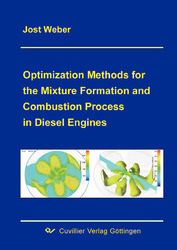| Fachbereiche | |
|---|---|
| Buchreihen (96) |
1378
|
| Nachhaltigkeit |
3
|
| Gesundheitswesen |
1
|
| Geisteswissenschaften |
2365
|
| Naturwissenschaften |
5406
|
| Ingenieurwissenschaften |
1793
|
| Allgemeine Ingenieurwissenschaften | 292 |
| Maschinenbau und Verfahrenstechnik | 862 |
| Elektrotechnik | 686 |
| Bergbau- und Hüttenwesen | 30 |
| Architektur und Bauwesen | 75 |
| Allgemein |
98
|
|
Leitlinien Unfallchirurgie
5. Auflage bestellen |
|
Erweiterte Suche
Optimization Methods for the Mixture Formation and Combustion Process in Diesel Engines
Jost Weber (Autor)Vorschau
Inhaltsverzeichnis, Datei (71 KB)
Leseprobe, Datei (100 KB)
The optimization of the combustion and mixture formation process in Diesel engines
by CFD simulations requires a reliable model approach as a pre-requisite in order to
predict combustion and emissions. A general and commonly used model for the liquid
spray is the discrete droplet model. Sub-models for droplet breakup, collision and coalescence,
and evaporation are available in the CFD code. With regard to combustion,
the flamelet model approach is interactively coupled with the CFD code, known as
RIF model. It benefits from a one-dimensional description of the thin reaction zone
in the flame. By this approach, a detailed reaction mechanism for the model fuel can
be used. Sub-mechanisms for NOx formation and a soot model are included. The
reaction mechanism has been modified in this work to account for a correct ignition
delay and heat-release at low-temperature conditions e.g. in the PCCI combustion.
The modeling of the mixture formation in a spray contains uncertainties in the model
constants and initial conditions. Spray data is required to calibrate the spray model.
At least, the spray penetration has to be measured under engine like conditions as
performed in a spray chamber. The spray penetration is interpreted as a criterion
for the mass and momentum exchange between the spray and the surrounding gas
on a macroscopic level. Finding a good agreement for the spray penetration between
simulation and experiment defines an optimization problem. That agreement is expressed
in an Euclidean norm as a merit function. The objective is to minimize this
merit function. The search for an appropriate set of spray model parameters and
initial conditions is denoted here as calibration of the spray model. Six parameters
have been identified, spanning a six dimensional parameter space. A manual search
is not feasible anymore but the implemented Genetic Algorithm is suitable to find
a global optimum where a good agreement between measured and simulated spray
penetration is obtained. If the same spray parameters are applied to a virtual engine
case, a similar good agreement is achieved although the mesh resolution is much finer
and the mesh topology is different than for the spray chamber simulation. From this
result, spray data for engine simulations should be provided and be used for sake of
calibration before the engine simulation is conducted. Additionally data is obtained
by PDA measurements at discrete points in the spray. That measurement technique
is, however, limited to less dense areas. Nevertheless, it shows that also local data is
in agreement with the simulation data. Agreement with spray penetration is thus a
relatively good choice and accounts also for the physics on a local or microscopic level.
That hypothesis is well supported by the data from the ethanol spray calibration.
The excellent agreement with regard to the global spray penetration is reflected by
the 2D comparison of liquid and vapor fuel concentrations and temperature, respectively.
Furthermore, a similar good agreement in spray penetration is obtained if the
breakup and collision model is not used. In that case, the spray penetration is only
controlled by the evaporation process. The Genetic Algorithm finds a point in the
parameter space with an initial SMR that is of the order of size of the outcome of the
secondary droplet breakup.
However in engine simulations, spray data is not always available. In that case the
spray parameters have to be adjusted. That adjustment is carried out following a
methodology that is presented in this work. Mainly, SOI and EGR variations have
to be used to calibrated the spray and combustion model. That approach has been
investigated for three different engine data sets for conventional and PCCI combustion
mode.
On the Cummins QSX engine, a conventional combustion has been studied. Spray
parameters are subject of adjustment. On the Duramax 6600 Diesel engine, a conventional
and PCCI combustion mode are investigated. For the PCCI combustion mode,
the reaction mechanism is modified in order to account for a correct ignition delay in
the low temperature combustion regime. The comparison between engine data and
results from the simulation indicates a good agreement for the combustion and engineout
emissions. On the Duramax full load case, most uncertainties are addressed to the
spray-wall interaction. Uncertainties from physical not well based models will always
occur in the engine simulation. Therefore, calibration of these models is a mean to
quantify its influence and minimize the discrepancies.
| ISBN-13 (Printausgabe) | 3867277249 |
| ISBN-13 (Printausgabe) | 9783867277242 |
| ISBN-13 (E-Book) | 9783736927247 |
| Sprache | Englisch |
| Seitenanzahl | 266 |
| Auflage | 1 Aufl. |
| Band | 0 |
| Erscheinungsort | Göttingen |
| Promotionsort | TH Aachen |
| Erscheinungsdatum | 02.09.2008 |
| Allgemeine Einordnung | Dissertation |
| Fachbereiche |
Allgemeine Ingenieurwissenschaften
Maschinenbau und Verfahrenstechnik |
| Schlagwörter | Dieselmotor, Verbrennung,CFD, Spray, Simulation Modell, Flamelet, Kraftstoffeinspritzung, Optimierung, Genetische Algorithmen, PCCI |








